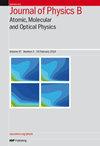Both experimental and molecular dynamics approaches highlight the central role of interfacial water for radical production by irradiated gold nanoparticles
IF 1.5
4区 物理与天体物理
Q3 OPTICS
Journal of Physics B: Atomic, Molecular and Optical Physics
Pub Date : 2024-03-13
DOI:10.1088/1361-6455/ad2e28
引用次数: 0
Abstract
Nanoparticles devoted to improve radiotherapy treatments are an efficient tool if they can induce the formation of deleterious species in the tumor. Their interaction with radiation is responsible for radical production but in spite of the numerous studies mostly with cells, no consensus has been reached about radical formation mechanism. In order to gain knowledge in the physico-chemical step of this phenomenon, we applied a very sensitive test to quantify hydroxyl radicals and electrons produced when gold atoms, organized as nanoparticles or as a salt in solution, are irradiated by keV and MeV photons (x- and实验和分子动力学方法都强调了界面水在辐照金纳米粒子产生自由基过程中的核心作用
如果纳米粒子能够诱导肿瘤中有害物质的形成,那么它就是一种有效的工具,可以改善放射治疗的效果。纳米粒子与辐射的相互作用会产生自由基,但尽管进行了大量研究,主要是针对细胞的研究,但对自由基的形成机制尚未达成共识。为了了解这一现象的物理化学步骤,我们采用了一种非常灵敏的测试方法,对以纳米颗粒或盐溶液形式存在的金原子在接受 keV 和 MeV 光子(x 射线和 γ 射线)照射时产生的羟基自由基和电子进行量化。界面水的关键作用被认为可以解释在纳米粒子中测得的大量自由基。经典分子动力学模拟对这些实验数据进行了补充,揭示了纳米粒子表面水氢键网络的特殊组织结构,这可能是辐照胶体悬浮液产生自由基机理的关键组成部分。
本文章由计算机程序翻译,如有差异,请以英文原文为准。
求助全文
约1分钟内获得全文
求助全文
来源期刊
CiteScore
3.60
自引率
6.20%
发文量
182
审稿时长
2.8 months
期刊介绍:
Published twice-monthly (24 issues per year), Journal of Physics B: Atomic, Molecular and Optical Physics covers the study of atoms, ions, molecules and clusters, and their structure and interactions with particles, photons or fields. The journal also publishes articles dealing with those aspects of spectroscopy, quantum optics and non-linear optics, laser physics, astrophysics, plasma physics, chemical physics, optical cooling and trapping and other investigations where the objects of study are the elementary atomic, ionic or molecular properties of processes.

 求助内容:
求助内容: 应助结果提醒方式:
应助结果提醒方式:


